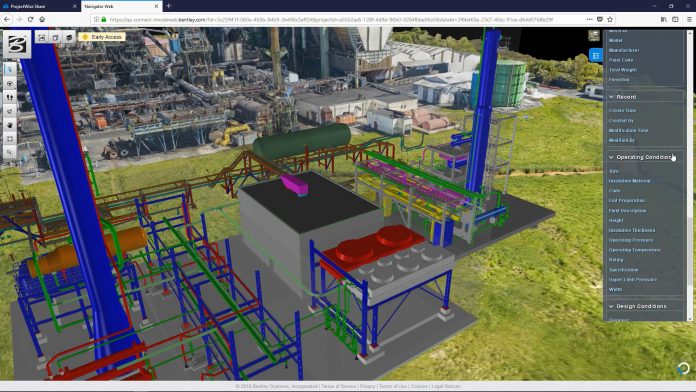As digital twins advance beyond BIM and GIS, what do you need to know? Bentley’s founder, Keith Bentley offers sage advice to help you make an impact
Our industry is quickly catching on to the significant gains that can be realised by digital twins with more than half of all large industrial companies expected to use digital twins in some form by 2021. The technology is rapidly advancing from vision to reality. Many organisations have already put twin technology ideas into action.
There are many proof points that indicate digital twins have entered the mainstream. Here are some key takeaways:
What is a digital twin?
The term is commonly used now, and infrastructure professionals are beginning to intuitively understand what a digital twin is and what it does. Bentley did not invent the term or concept. In fact, the term did not even originate from the infrastructure industry. I believe that the concept of a twin is quite simple. If you have a physical asset and a digital asset that would represent everything in the physical asset, you could join them together, using the digital one for understanding what is happening with the physical asset in the real world.
The one problem, however, is that assets change all the time. Even with a large-scale infrastructure asset, while the entire asset probably does not change all that much, some part of the asset changes every day. A digital twin must connect from the physical world to the digital world. If you have a twin and it does not reflect the current state in the real world, not only is it not going to be valuable, but it could be dangerous. This connection also means that the reverse can be true: the digital world needs to connect to the physical world, allowing you to change the digital representation in preparation for changes that you plan to make to the physical asset.
When thinking about how things change over time, twins are about marrying the two worlds and keeping them in sync. That idea makes a twin different from what has been talked about before. While digital twins must have that dimension of time, they must also have context. If you have sensors out in the real world that are telling you what is happening, you should be able to visualise that data with your digital twin. Things like reality capture, such as what Bentley’s ContextCapture provides, should be a part of it.
Simply put, a digital twin is a connection of data sources. Sometimes, those data sources are created by software like design applications. Sometimes, they are combined with other systems.
What is the value of twin technology?
The value of a digital twin will grow and multiply when connections are formed. The more of them that are formed, the greater the value is. Digital twins provide opportunities, such as opportunities to improve the processes that exist today. They can help you with costs, safety, resilience, and even your carbon footprint.
However, digital twins provide not only the opportunity to change the design process, but to also change the business process. If industry professionals can improve their metrics—such as cost efficiency and safety—they are creating value. If that added value can be ascribed to the person who made it possible, the industry has a selfish motive: improving the bottom line for the asset’s entire lifecycle.
Ultimately, I believe that opportunity and optimism are the value that a digital twin can bring to the infrastructure industry—value that can provide significant advantages.
What is there to consider when describing digital twin deployment?
When people start describing how you should deploy a digital twin, the one word that should come to mind is flexibility.
While no one knows what a digital twin is going to be five years from now, it will certainly be connected to more systems than are possible today. The industry wants the flexibility to change as requirements change and as things become possible that were not before. In software terms, and what we at Bentley believe, that means being open.
Infrastructure professionals want the flexibility to be able to take data and combine it with other data sources, send it to other systems, or give it to another vendor to have them write some software. While that does not mean that you should start becoming programmers, you should have the flexibility to do that if you choose.
What’s next?
Not everything is going to be perfect. It is not all going to work the first time. With software development, you need to be agile and work within the cycle of build, measure, learn. For Bentley, this cycle is ongoing and repeats every three weeks. Even if you build something, you run it, you test it, and you see whether your hypothesis is being satisfied. If it is not, you adjust. That cycle repeats so quickly, allowing you to react to whatever works and stop doing whatever does not work.
Creating a digital twin does not require stopping anything that you are already doing. Once you are more familiar with digital twins, then you may decide to stop doing manual processes, such as creating PDF files. You will be much happier if you start with a successful project and adapt from there rather than trying to switch everything at once.
As digital twins continue to be implemented, the industry will continue to see changes in the technology landscape. One place where infrastructure professionals want to see advancements with digital twins is with machine learning. As you begin or continue thinking about where you and your projects can use digital twins, a good starting point is visiting http://www.bentley.com/iTwin to learn how Bentley can help you with going digital with digital twins.
This perspective is based on Keith Bentley’s Year in Infrastructure Technology Keynote address, given on October 24, 2019 in Singapore.
Keith Bentley
Founder and chief technology officer
Bentley System














